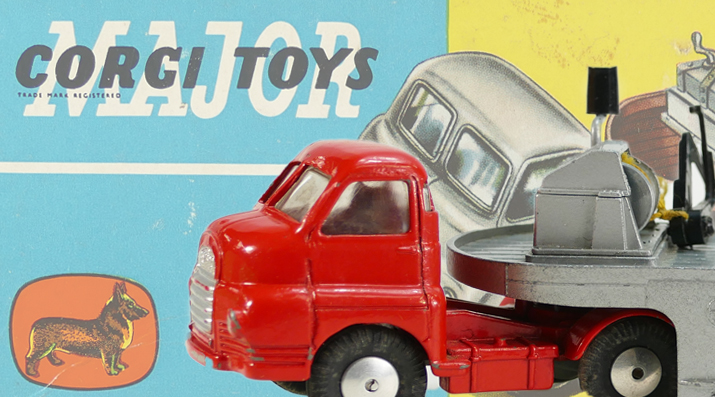
CORGI TOYS
Corgi Toys is the name of a range of die-cast toy vehicles produced by Mettoy Playcraft Ltd., in the United Kingdom. Mettoy was founded in 1933 by Philip Ullmann in Northampton, England. He was joined by Arthur Katz and they decided to market a range of toy vehicles as competition to Meccano’s Dinky Toys model vehicles, which had dominted the British Market for many years.
Corgi Toys were introduced in the UK in July 1956 and were manufactured in Swansea, Wales for 27 years.
The range was exported worldwide and sold in large numbers. Some of the best known and most popular models were of cars made famous in film and television such as the Batmobile, Chitty Chitty Bang Bang and James Bond’s Aston Martin DB5, which remains the largest selling toy car ever produced.
Prior to the introduction of Corgi Toys, Mettoy mainly produced tin plate toys. However, in the early 1950s, they began producing a few products in cast metal. The first was a large scale wind-up racer made with a cast aluminum body and tin plate wheels. The body material was soon changed to die cast zinc and it was refitted with cast wheels and molded rubber tires. Other models followed and the product line was given the name “Castoys.” These were the direct ancestors of Corgi Toys. Two models from this range are notable to Corgi Toys collectors. The first was a promotional Karrier Bantam bottle truck produced for CWS Soft Drinks, but not otherwise released. The second was a die cast service ramp used in a tin plate service station set. Both of these models would later reappear in slightly revised forms as Corgi Toys 455 and 1401.
The name ‘Corgi Toys’ was chosen by Philip Ullmann in honour of the company’s new home, taken from the Welsh breed of dog, the Corgi, and the iconic Corgi dog logo branded the new range. The name was short and easy to remember, further aligning the range with their rival Dinky Toys. Corgi Toys also included plastic glazing, which lent the models a greater authenticity, and they carried the advertising slogan “the ones with windows”.
Unlike Dinky Toys, which until the mid-1950s were supplied to the toy retailer in trade packs of six models and then sold loose to the customer, Corgi Toys were always supplied in individual boxes featuring an illustration of the model incorporated into the box design. The original design has become known to collectors as the ‘blue box’ because of its blue and black colour scheme, and lasted from the July 1956 range launch until the iconic blue and yellow colour scheme was introduced in January 1959.
The biggest re-design in Corgi’s packaging came in 1966 with the introduction of the ‘window box’, so called because the model was clearly visible through a plastic window incorporated into the box, initially only on a few Majors and Gift Sets while the main range still retained the cardboard box. The blue and yellow colour scheme was left unchanged.
An update of the box design was introduced in May 1973 which featured an angled inner plinth so the model sat at an angle towards the front of the box, making the box taller than the previous (usually called the ‘slimline box’). The colour scheme changed to dark blue with three stripes of varying colours; yellow, orange, red, purple or cyan surrounding the box window. While the ‘slimline box’ still used painted artwork on the rear these new boxes showed photos of other models in the range.
The last Corgi logo used by Mettoy from 1981 until its demise in 1983, and then briefly by Corgi Toys Ltd. in 1984.
Below are some of the toys sold in previous sales.
.jpg) Corgi Carrimore Car Transporter Gift Set no28 by Playcraft Toys Ltd in original box with paperwork in good condition. Sale Price £280.00
Corgi Carrimore Car Transporter Gift Set no28 by Playcraft Toys Ltd in original box with paperwork in good condition. Sale Price £280.00
 Corgi Toys Articulated Milk Tanker 1129 in original box. Sale Price £120.00.
Corgi Toys Articulated Milk Tanker 1129 in original box. Sale Price £120.00.
 Corgi Toys boxed Lotus racing team set, gift set no 37. Sale Price £180.00.
Corgi Toys boxed Lotus racing team set, gift set no 37. Sale Price £180.00.
 Corgi Toys Chipperfields Land Rover with Elephant and Cage on Trailer, gift set no 19 in original box. Sale Price £80.00.
Corgi Toys Chipperfields Land Rover with Elephant and Cage on Trailer, gift set no 19 in original box. Sale Price £80.00.
 Corgi Toys Circus Horse transporter with horses set1130 in original box in good condition. Sale Price £80.00.
Corgi Toys Circus Horse transporter with horses set1130 in original box in good condition. Sale Price £80.00.
 Corgi Toys E R F Dropside Lorry and Platform Trailer with Cement and Plank loads, gift set no 11 in original box with paperwork in good condition. Sale Price £75.00.
Corgi Toys E R F Dropside Lorry and Platform Trailer with Cement and Plank loads, gift set no 11 in original box with paperwork in good condition. Sale Price £75.00.
 Corgi Toys Farming models Gift Set no 22, boxed with paperwork in good condition. Sale Price £310.00.
Corgi Toys Farming models Gift Set no 22, boxed with paperwork in good condition. Sale Price £310.00.
 Corgi Toys Land Rover with Rices Pony Trailer and pony , Gift Set no 2 in original box with paperwork in good condition. Sale Price £85.00.
Corgi Toys Land Rover with Rices Pony Trailer and pony , Gift Set no 2 in original box with paperwork in good condition. Sale Price £85.00.
 Corgi Toys Lotus Racing Team gift set 37, in original box. Sale Price £150.00.
Corgi Toys Lotus Racing Team gift set 37, in original box. Sale Price £150.00.
.jpg) Corgi Toys Mercedes-Benz 300SL. Open Roadster, 303s in original box in good condition. Sale Price £75.00.
Corgi Toys Mercedes-Benz 300SL. Open Roadster, 303s in original box in good condition. Sale Price £75.00.
Dinky Toys
Dinky Toys was the brand name for die-cast Mazak zinc alloy miniature vehicles produced by Meccano Ltd. They were also made in England from 1934 to 1979 at a factory in Binns Road, Liverpool. Dinky Toys were among the most popular die-cast vehicles ever made – predating other popular die-cast marques, including Corgi, Matchbox, and Mattel’s Hot Wheels.
In the mid-1930s, six vehicles were introduced including a sports car, a sports coupe, a truck, a delivery van, a farm tractor, and a tank. They were all cast in lead.
All of the early cars were inaccurate representations and had die-cast metal bodies, chassis and wheels with rubber tyres. By August 1935 there were around 200 different products in the Dinky Toys range which included die-cast ships, aeroplanes and small trains. Dinky Toys model cars were available individually in trade packs of 6 cars per pack. Most models were not available in individual boxes until 1952.
 Dinky Supertoys Leyland Octopus Tanker – Esso Petroleum – in Original Box. Sale Price £120.00.
Dinky Supertoys Leyland Octopus Tanker – Esso Petroleum – in Original Box. Sale Price £120.00.
Other toys sold by Potteries Auctions.
 Louis Marx and Co Fred Flintstone Battery Operated Flivver in Original Box. Sale Price £150.00.
Louis Marx and Co Fred Flintstone Battery Operated Flivver in Original Box. Sale Price £150.00.
 Louis Marx and Co Yogi Bear Scooter in Original Box. Sale Price £95.00.
Louis Marx and Co Yogi Bear Scooter in Original Box. Sale Price £95.00.
 Plaston Supercar by Shipton Plastics, 1961 in Original Box. Sale Price £420.00.
Plaston Supercar by Shipton Plastics, 1961 in Original Box. Sale Price £420.00.
 Quercetti Fireball XL5 Spaceship based on Steve Zodiac Supermarionation in Original Box. Sale Price £150.00.
Quercetti Fireball XL5 Spaceship based on Steve Zodiac Supermarionation in Original Box. Sale Price £150.00.
 Scale Model Stingray Friction Motor by Fairylite Empire Made in original box. Sale Price £260.00.
Scale Model Stingray Friction Motor by Fairylite Empire Made in original box. Sale Price £260.00.
If you have any toys you would like valued or put into a sale, please contact us.
Selling at Auction
If you have Corgi Toys you’re looking to sell, these pieces
consistently perform well at auction and our staff is well-placed to provide
valuations and advice on selling your items. Call 01782 638100 or
emailenquiries@potteriesauctions.com to book a valuation appointment to attend
one of our Tuesday valuation days. We also provide valuations via WhatsApp,
simply send some clear photographs of your items via the app to 07864 667940.
Additionally, we can send you links to our catalogues via WhatsApp–message the
above number via the app and ask to receive our catalogues. Make sure you are
subscribed to our email newsletters, too!
